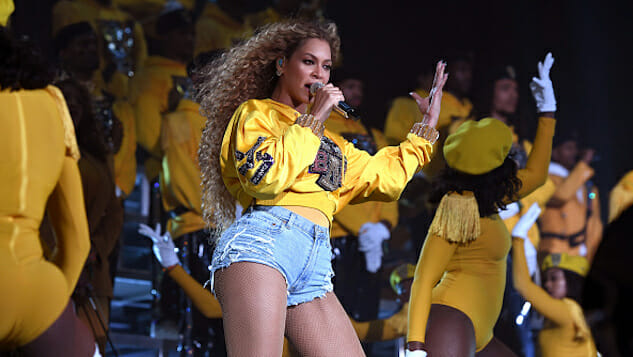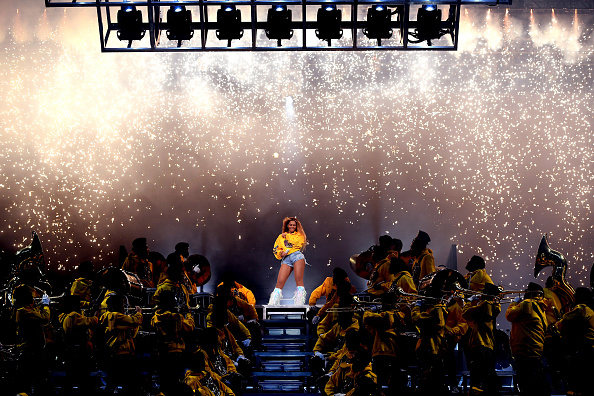7 Takeaways from Beyoncé’s Homecoming Documentary
Bey's difficult pregnancy, Blue Ivy's angelic pipes and the brilliance of Beychella
All photos by Larry Busacca/Getty
Thousands of festival-goers will flock to the California desert this weekend for the second installment of Coachella 2019. They’ll see Childish Gambino, Ariana Grande, Tame Impala and even a special edition of Kanye’s “Sunday Service,” if they’re lucky. But it’s unlikely any of those performers will be able to match the grandiosity of Beychella, Beyoncé’s epic pair of sets at last year’s festival. On Wednesday, Netflix dropped Homecoming, a documentary written, produced and directed by Mrs. Knowles-Carter herself that features stunning footage of each weekend’s set and dives deep into the symbolism, production and eight-month rehearsal process behind Beychella. The film also arrived with a surprise live album encompassing the entire Coachella set as well as new music. It’s all just The Carters’ latest in a long line of masterpieces. If you haven’t seen it yet, you might want to consider canceling your Friday night plans. Bey deserves your full attention. Rounding up the best moments from this shimmering slice of pop culture history was no easy task, but it was one I eagerly accepted. Read on for the best discoveries, insight and moments from the colossal film event that is Homecoming.
1. Beyoncé isn’t a superhuman. But she’s pretty dang close.
Beyoncé has always been considered not only a sex symbol, but also part of another caliber of humanity entirely—a goddess with the voice of angel, the body of a model and a supernatural beauty. But in the course of Homecoming, we see another side of Beyoncé Giselle Knowles-Carter. The harrowing pregnancy that forced her to reschedule her originally slated appearance at Coachella 2017 and brought Rumi and Sir Carter into the world resulted in complications like high blood pressure and preeclampsia (a dangerous, potentially fatal pregnancy condition). After an emergency C-section, Rumi and Sir thankfully arrived safely, but the road to getting back in shape after her pregnancy was a difficult one.
“There were days where I thought I’d never be the same,” Beyoncé says at one point during the voiceover that narrates the film. “I’d never be the same physically. My strength and endurance would never be the same.”
She was 218 pounds the day she gave birth. But after months of training and adhering to a strict vegan diet, Beyoncé got her body back. And she did it all through nearly eight months of intense Beychella rehearsals, breastfeeding the twins and mothering Blue. So maybe Beyoncé’s only superpower is hard work.
2. Beychella was first and foremost a celebration of black brilliance
Beyoncé reveals in Homecoming she always wanted to attend a Historically Black College or University. She was, of course, busy with Destiny’s Child (who also make an appearance during the Coachella set) and her ascent to pop stardom during her teen and college years—so she never got the chance. Throughout her childhood in Houston, she attended battles of the bands and other campus events at HBCUs like Prairie View and wanted to bring the same feeling of community to her performance. Backed by an all-black marching band, dance squad and step team, Beyoncé—wearing Greek letters—threw the Homecoming she never had at Coachella. We see clips from football games at schools like Howard University and Alabama A&M interspersed with Beychella rehearsal footage. The entire performance and film are a celebration of those institutions, and perhaps even an antithesis to what most people would consider a primarily white experience—Coachella. Beyoncé says it best herself in the voiceover: “When I decided to do Coachella, instead of me pulling out my flower crown it was more important that I brought our culture to Coachella,” she says.
3. Blue Ivy embraces the spotlight
We got our first glimpse at bubbly Blue Ivy when the Homecoming trailer dropped earlier this month, but in the film she steals the show for an entire scene so cute it should be illegal. Towards the end of the film, we see Blue backstage singing “Lift Every Voice and Sing,” which also appears on the live album Bey surprise-dropped Wednesday morning with the documentary. After a small crowd applauds Blue’s performance, she emphatically says, “I want to do it again” to which Bey replies, “You’re like mommy huh?” Then Blue says, “It feels good.” Who runs the world? Blue Ivy, that’s who.
4. Sisterhood and family are hugely important for Beyoncé
This might be an obvious one, but Bey explicitly states in Homecoming that her family is her “biggest priority” and her “tribe.” But it just so happens that Beyoncé’s family has been inextricably wrapped up in her career for the entirety of her life in the public eye. Throughout Homecoming, Bey pays homage to her immediate family—her husband Jay-Z, who makes a short appearance during the set, and her children, Blue, Rumi and Sir—as well as her sisters. Solange, her sister by blood, comes on the Coachella stage for a wild dance duet with Bey that might be the most fun five minutes of the entire show, and Michelle Williams and Kelly Rowland, her sisters in Destiny’s Child, make a cameo to perform some hits as a trio, including “Say My Name,” which had the massive ‘Chella crowd absolutely losing their minds.
5. Beyoncé is a master director, visualist and leader
Eight months of rehearsal went into making Beychella happen. And Bey, wearing a Howard sweatshirt, no makeup and toting her children around, was at the head of it all. Sure, there were various department heads overseeing the different aspects of the performance—costumes, choreography, casting, etc.—but Beyoncé had her hand in all of it in one way or another. She says in the film she hand-picked every dancer, she collaborated with designers to ensure every sequin and shade on stage contributed to the overall symbolism of the show and she wrote, directed and executive produced Homecoming. She not only paid special attention to how the show would look to thousands of festival-goers each weekend of Coachella, but also how it would look on camera—for the people in the back of the crowd, and for those of us watching from our couches. During the rehearsal process, we hear Beyoncé use words like “janky” to describe the show in its early stages. She means business, but she also appears overly gracious when talking about the hundreds of people who put forth blood, sweat and tears to pull off a performance of this magnitude. The result was a colossal, visually stunning spectacle that not only summarized Beyoncé’s 20-year career, but also celebrated black colleges in an entirely new way.
6. Coachella will never be this good again
We just covered the amount of hard work that went into executing this marvel. There’s no dispute about whether or not it’s a wonder to behold. But can any Coachella performance—or any festival set, for that matter—ever top it? Doubt. ful. Coachella, as we’ve discussed at length here at Paste, is more about perpetuating a vibe than it is about representing culture. It’s no Woodstock (and in 2019, Woodstock is no Woodstock, either). Coachella is where money and celebrities and the music industry’s flashiest personalities converge for two weekends of Instagramming and desert dancing. Artists like this year’s stars Ariana Grande and Billie Eilish will still put on spectacles of their own, but it’s difficult to imagine another performance of this cultural caliber. Beychella was a masterpiece and the culmination of years of work and hundreds of people. Beyoncé may be the star, but Beychella meant more for a community and a culture than this year’s lineup ever will.
7. Homecoming is just another chapter in The Carters’ dynastic autobiography
The Carters are the world’s most intentional artists. Every project isn’t just an album, a performance, a documentary—it’s a piece of their narrative, a narrative only they control. They have always addressed their personal lives through their own filters, i.e. their music—be it their respective breakdowns of marital trouble, Bey’s Lemonade and Jay-Z’s 4:44, or their epic reconciliation, last year’s EVERYTHING IS LOVE, and all of the accompanying visuals (most notably, the Louvre-set “Apeshit” video). The Carters will never hand their stories over to someone else, partly because they want to continue growing their billion dollar dynasty, but also because as some of the most famous people in the world, they value control. There was a story to tell about Beyoncé’s most recent pregnancy and the much-talked-about performance that followed it. And The Carters weren’t going to allow anyone else to tell it.








































